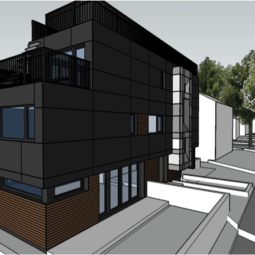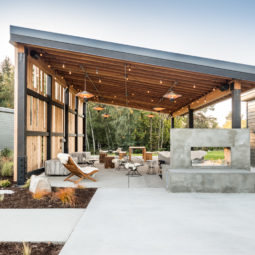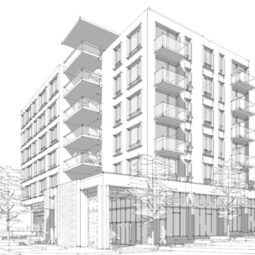
Passive House multifamily buildings use almost no energy and don’t cost much more than conventional buildings. They should be everywhere.
The standard excuse for not building to Passive House standards of energy efficiency has been that it costs a lot more than conventional building. However, this is becoming less and less true as builders get more experienced.
Sloan Richie of Cascade Built has lots of experience; he even lives in one that we have shown a few times on TreeHugger. Now he has built the grandly named Pax Futura, (which literally translates as The Future of Peace). It’s a rental apartment building with 35 small units designed by NK architects, who write:
Embracing a simple modern design, the building’s natural color palette is accented with metal canopies and signage, and sliding wood screening elements to create a dynamic facade. A courtyard activates the east facade with circulation, bench overlooks, and vertical landscape and screen elements.
The walls are made from Structural Insulated Panels (SIPs) mounted on the exterior of wood frame construction, with some glue-laminated beams on big openings. Solar gain is controlled by fixed sunshades on the the south end of the building, and by tenant-operated sliding exterior shutters on the west side.
The Passive House cost premium on multifamily housing is lower than on a single family house because there are so many shared surfaces; it is the exterior walls and windows that cost more than in conventional buildings. Heating and cooling systems can actually cost less because they can be much smaller or, in some cases, eliminated altogether. Here there are “heat pumps contributing additional cooling and heating to incoming air.”
All apartments have some kind of ventilation system, but in passive house these have to be Heat Recovery Ventilators. Sloan advises TreeHugger that “HRVs are from Zehnder and they are semi-decentralized, meaning one HRV serves multiple apartments but not the whole building.” When you compare this to how most apartments get their air, you quickly realize how much better this is; it should be a game-changer in rental buildings. There is a cost to this all, but it is not much; NK architects write:
Sloan estimates the incremental cost of achieving Passive House performance (compared to Seattle energy code) at just 5%. He expects that the lessons learned on this project will allow him to deliver his next Passive House building at closer to 2-3% cost “premium”. This modest cost delta for Passive House performance will slash energy use by 50% compared to a code-minimum building, reduce maintenance costs…
But there are other benefits that come from building to Passive House standards: it is a lot quieter (at least with respect to exterior noise) and you get “happier tenants (and therefore lower vacancy rates) thanks to superior comfort and clean air.” There are other features that make life better for tenants, including no-VOC finishes and natural bioretention planters to manage storm water onsite.
I am not totally convinced about the utility of the sliding exterior shutters and whether tenants will actually bother, but they do help make the building more visually interesting, a problem these days when people are used to all glass buildings. But really, we have to all get used to simpler forms, smaller windows, without jogs and bumps and bays; that is how you build an efficient and affordable building.
And when you look at the interior photo with the sunshade covering the big windows, it’s clear that they provide an additional bit of privacy. I suspect most tenants will just leave them in one place.
The units are also interesting, mostly studio apartments with big, accessible bathrooms. See all the plans on the Pax Futura website here.
NK Architects note: “Located in the heart of the hip Columbia City neighborhood, just blocks away from the light rail station, the building is a model of the kind of affordable, low carbon, urban living our cities need today.”
This is what so many of our successful cities need: “missing middle” four-storey buildings that can be squeezed into many small sites, close to transit and where people want to be. It is the kind of building that could solve our housing crisis and our energy crisis.




